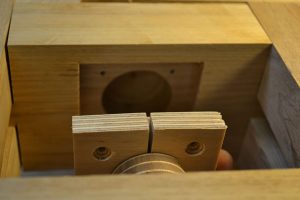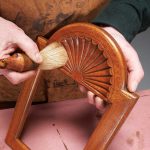We may receive a commission when you use our affiliate links. However, this does not impact our recommendations.
 I’m editing an article from Jeff Miller for the February issue, and, without giving too much away, it’s a simple setup for cutting perfect tenons on curved and angled workpieces (and it also works gangbusters on straight shoulders).
I’m editing an article from Jeff Miller for the February issue, and, without giving too much away, it’s a simple setup for cutting perfect tenons on curved and angled workpieces (and it also works gangbusters on straight shoulders).
Jeff came up with this idea, then discovered a similar solution in an old catalog from La Forge Royale. Not only does Jeff’s article present an elegant solution to a problem, it’s an excellent reminder that sometimes answers are right under our noses…though only if we have access a really good library. Here’s the intro:
The graveyard of obscure and forgotten tools is large, densely packed and many layers deep. Many of these tools richly deserve their pauper’s burial. But once in a while you come across a tool that does things that are quite remarkable, and you wonder why it ever disappeared in the first place.
I didn’t go rooting around for an old tool to dig up and bring back to life. I was simply trying to find a better way to cut tenon shoulders for some of my more complicated chairs. Cutting accurate, well-aligned shoulders even on a straight tenon is fairly difficult; cutting them on these chairs, where I had curved parts and angled shoulders ,was especially so.
I devised a solution, and then discovered that earlier chairmakers – of course – had long ago faced the same problem and had come up with a rather elegant solution. But elegant or not, the solution went the way of so many techniques.…
With these easily made tools, it’s possible to cut straight (or angled), perfectly-aligned shoulders on even curved workpieces. It’s worth noting that my adaptations are not attempts at a perfect reproduction. They were my attempt to make useful tools for my specific needs. But I have been surprised by how generally useful these tools are.
You’ll find the rest of the article – which includes step-by-step instructions on making the tools – in the February 2014 issue (it mails to subscribers just before Christmas, and will be on newsstands in early January).
— Megan Fitzpatrick
p.s. If you like vintage woodworking stuff, you might like to hang a Plate 11 poster (the one with the now-common workbench) from “L’art du menuisier” on your workshop wall (one of these days, I’ll get around to making a suitable frame for mine).
Here are some supplies and tools we find essential in our everyday work around the shop. We may receive a commission from sales referred by our links; however, we have carefully selected these products for their usefulness and quality.










I got to paw a prototype when Jeff hosted the Chicago area Lie-Nielsen event. I’m sure it will be a great article. Obviously, I’m already sold on the concept.
I wrote an article for the Feb 2013 issue of Highland Woodworking’s Online Newsletter on ‘Cutting compound Tenons on the Tablesaw’. It is a simple solution and works great. Here is the link:
http://www.highlandwoodworking.com/woodworking-tips-1302feb/compoundtenons.html
Sounds and appears to be the famous french chair maker’s vise.
“…I devised a solution, and then discovered that earlier chairmakers – of course – had long ago faced the same problem and had come up with a rather elegant solution. But elegant or not, the solution went the way of so many techniques….”
So did Jeff write about his solution or Roubo’s? i.e. Did he scrap his idea when he saw Roubo’s “rather elegant” solution or were they basically the same?
Also, kind of related, (it refers to your post script) Was plate 11 in the book LAP just released, or the next volume due out soon?